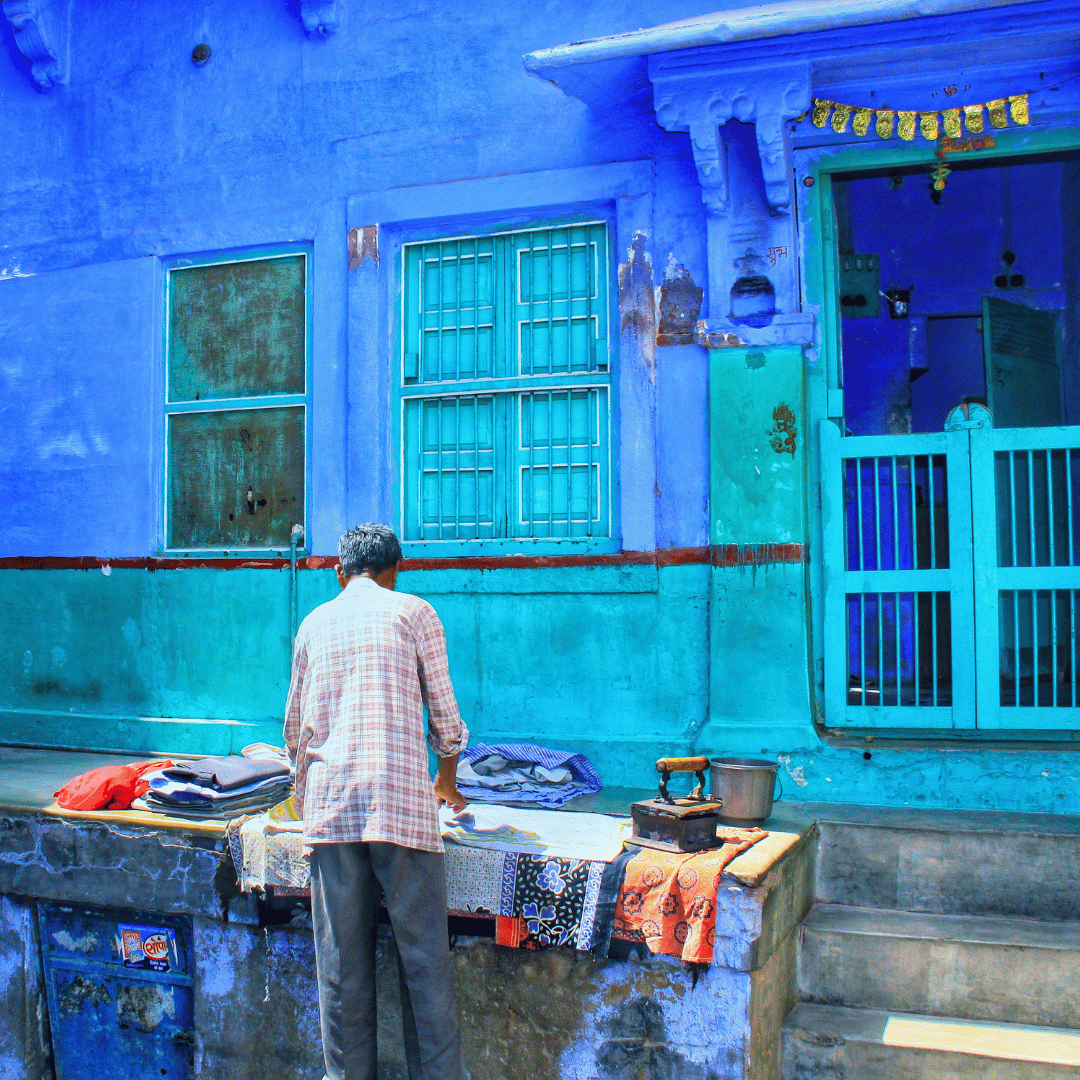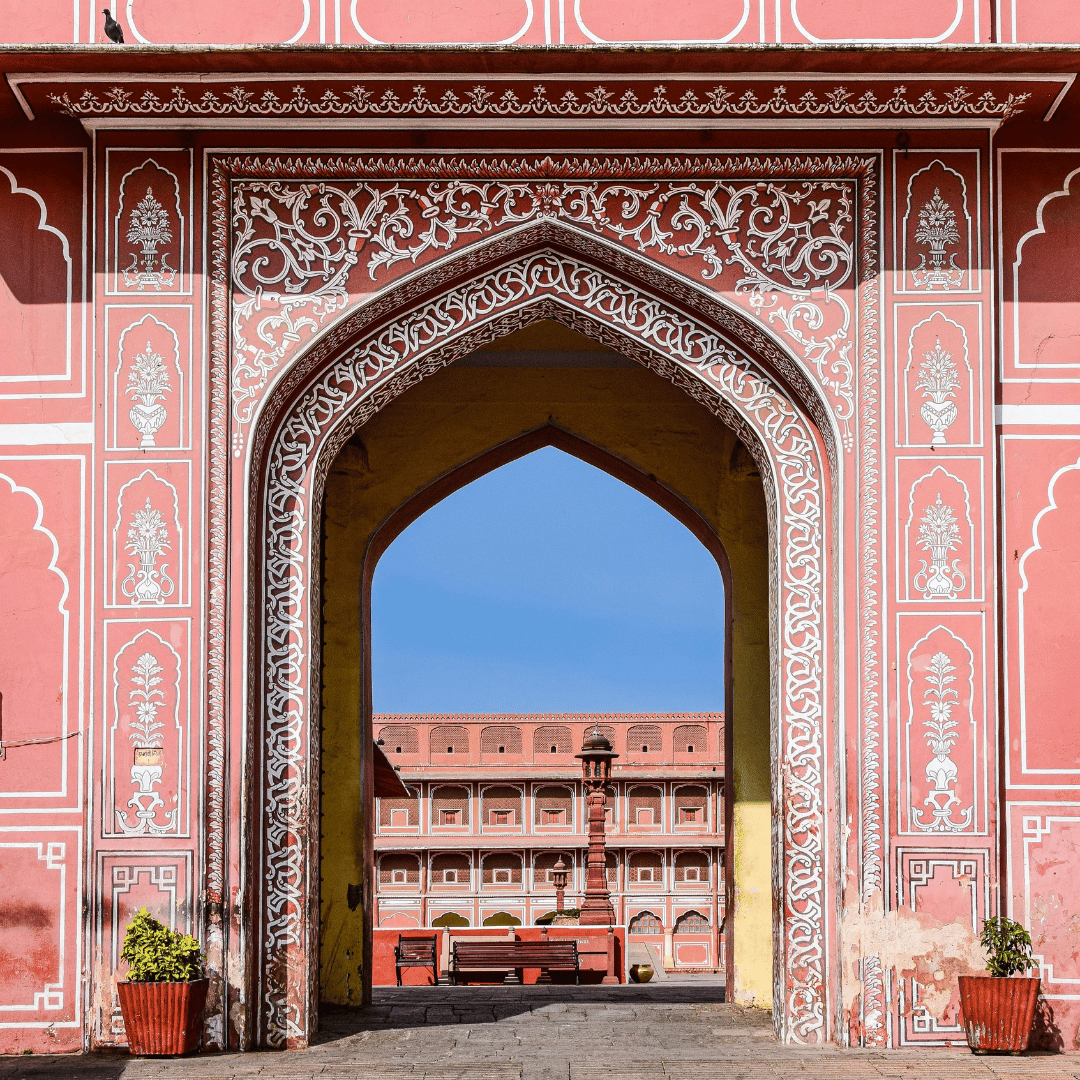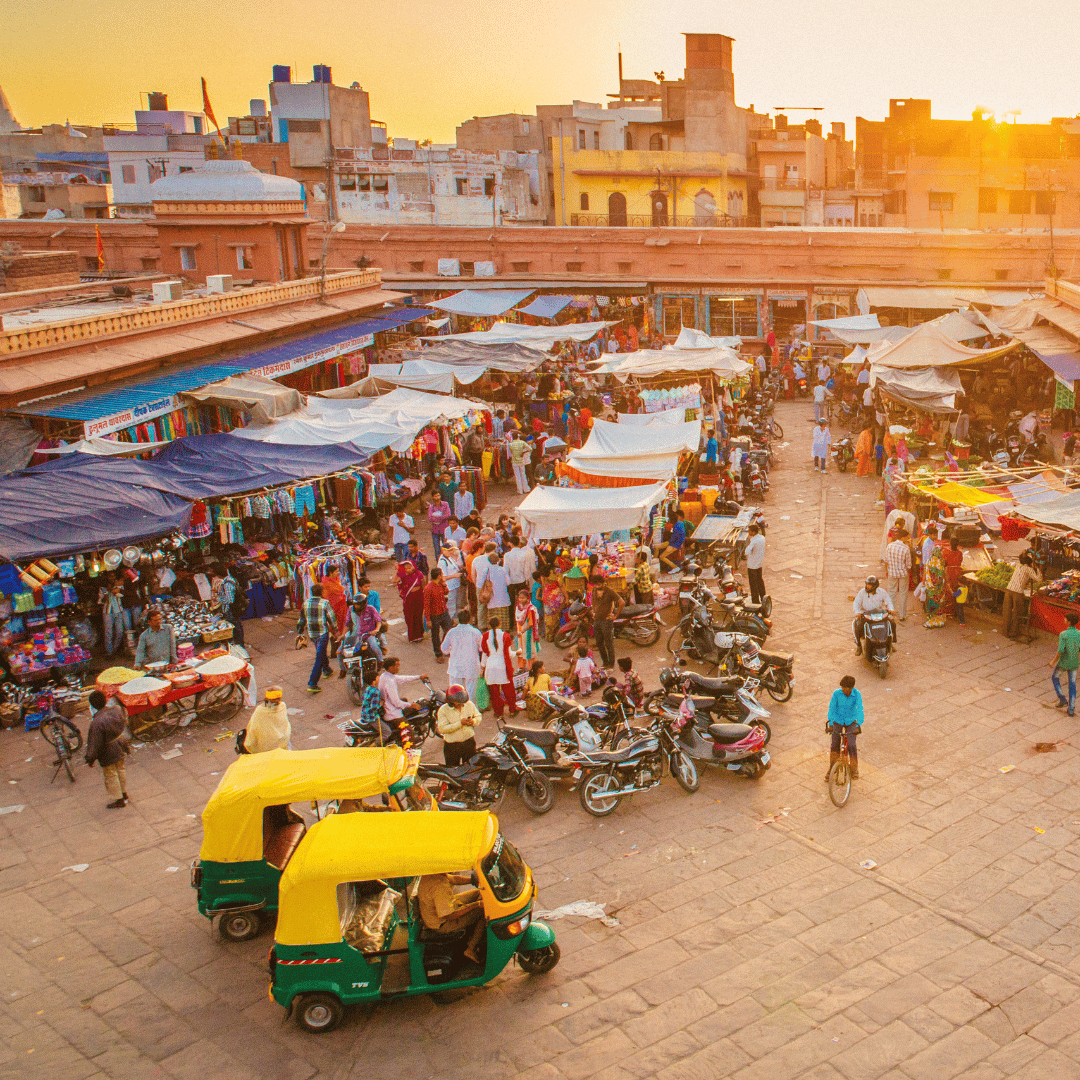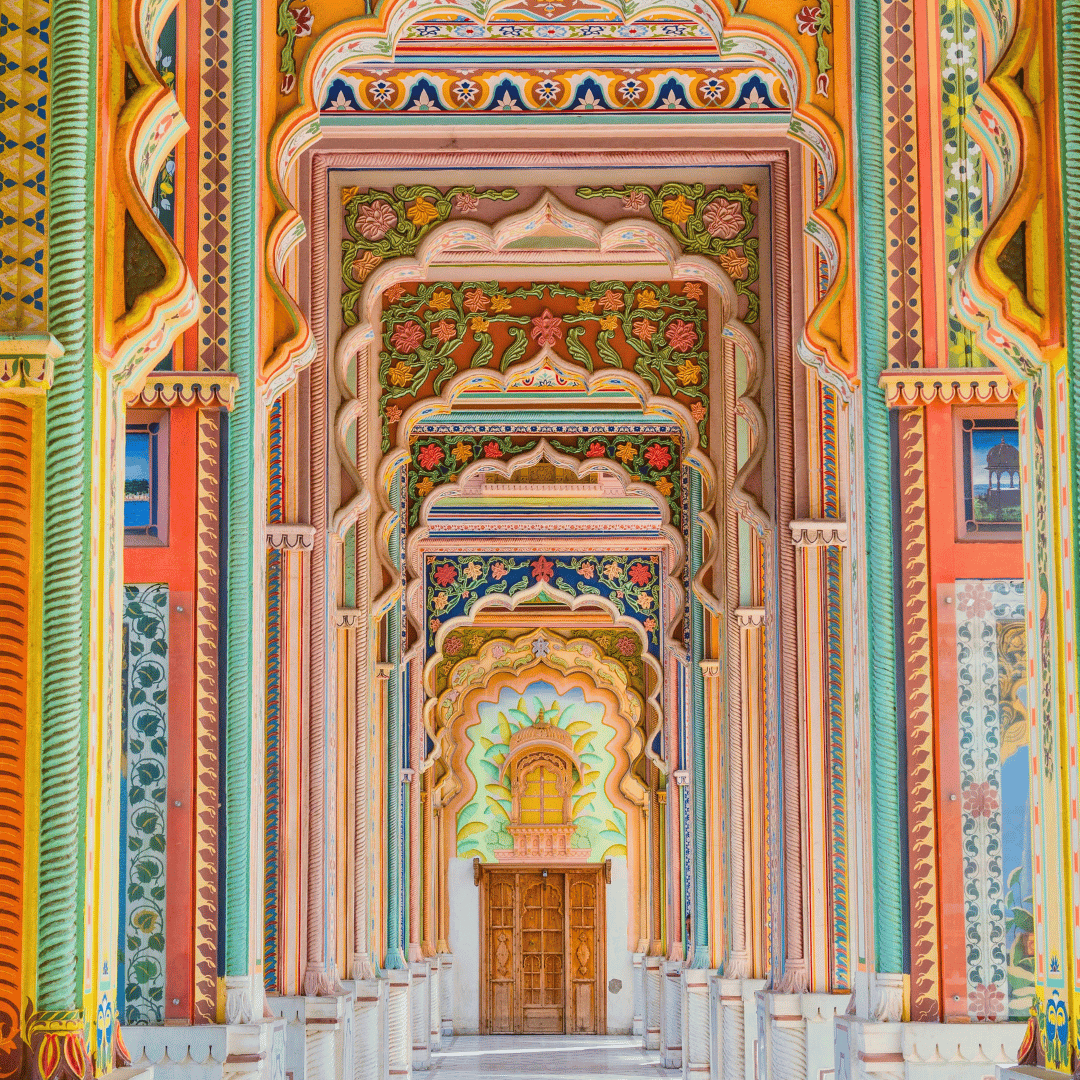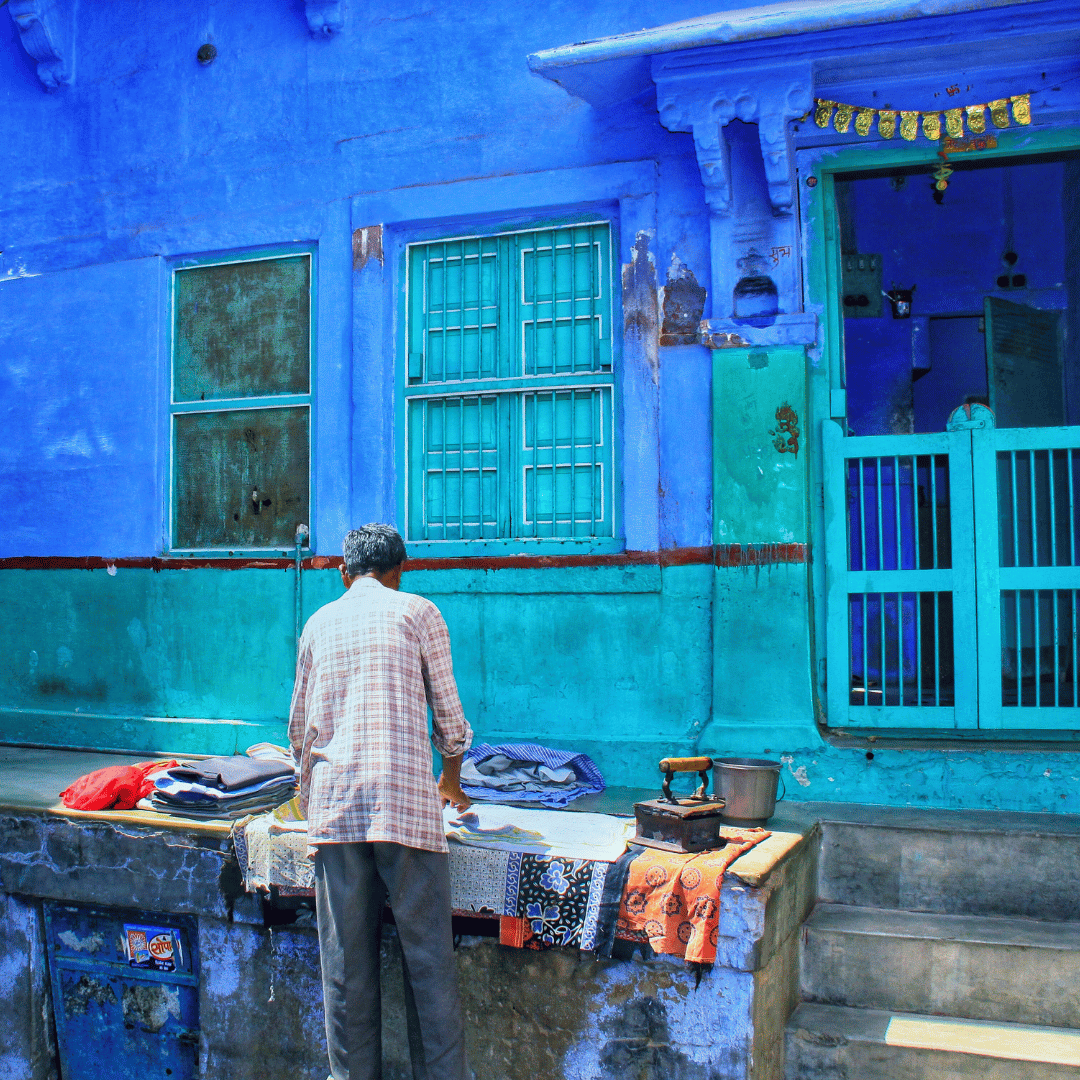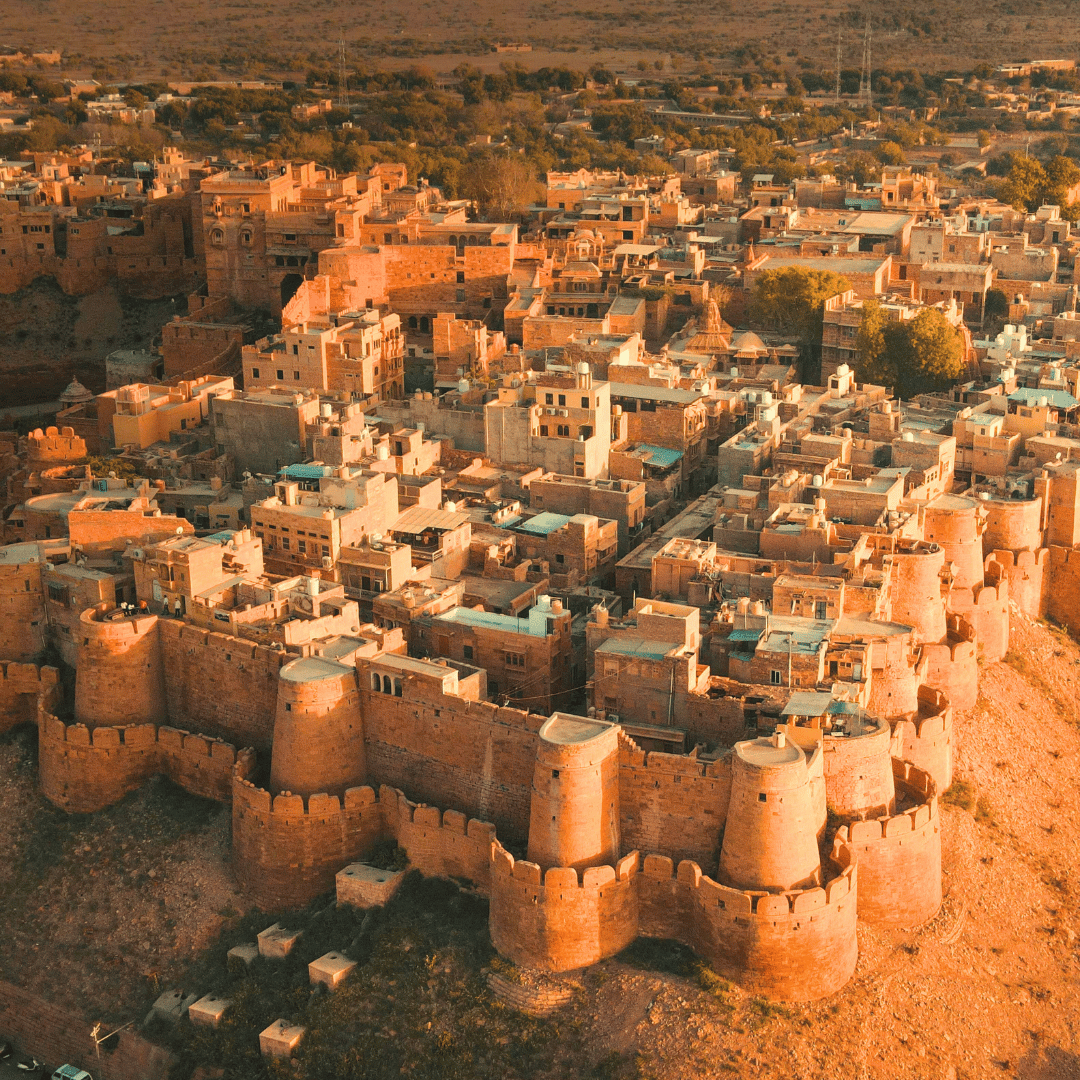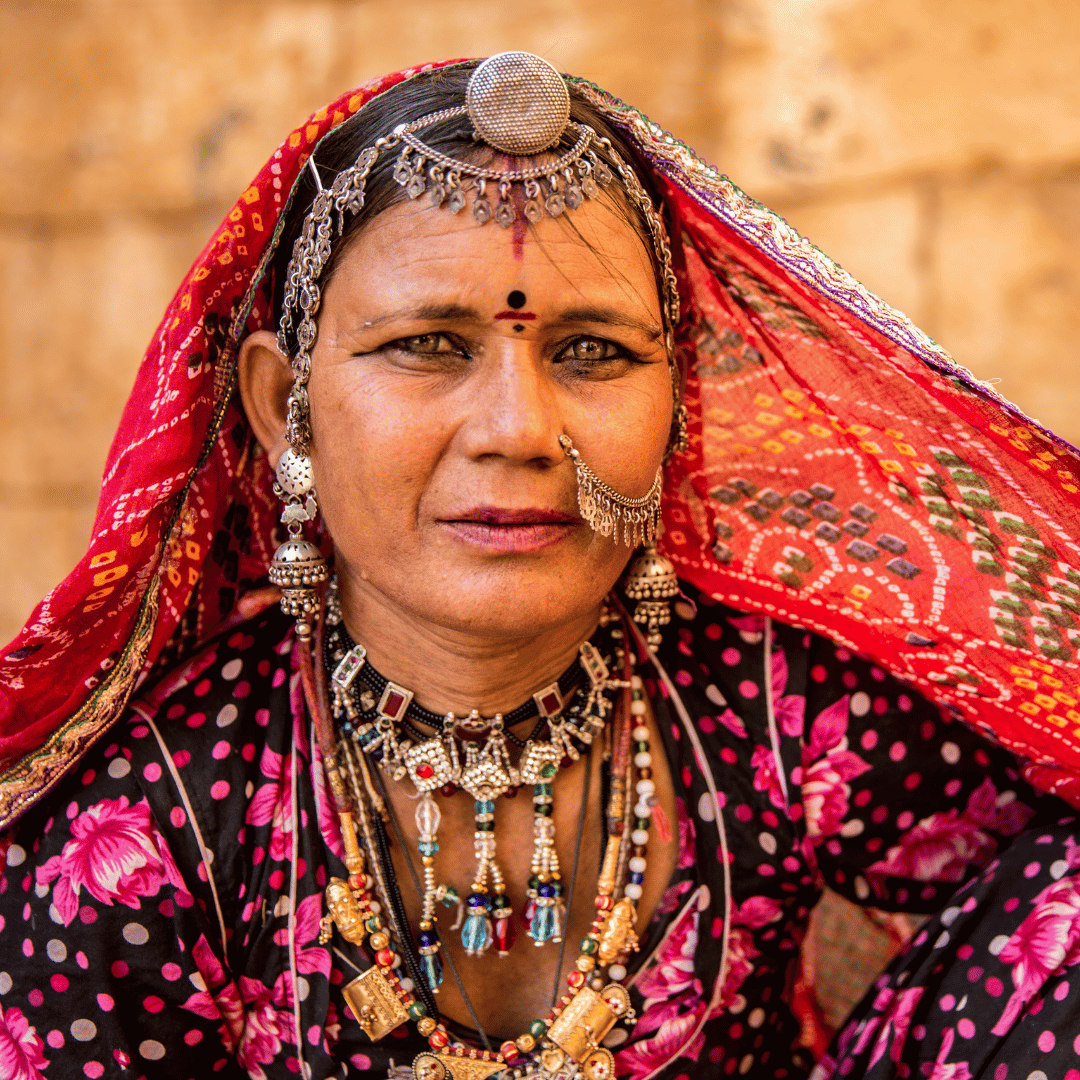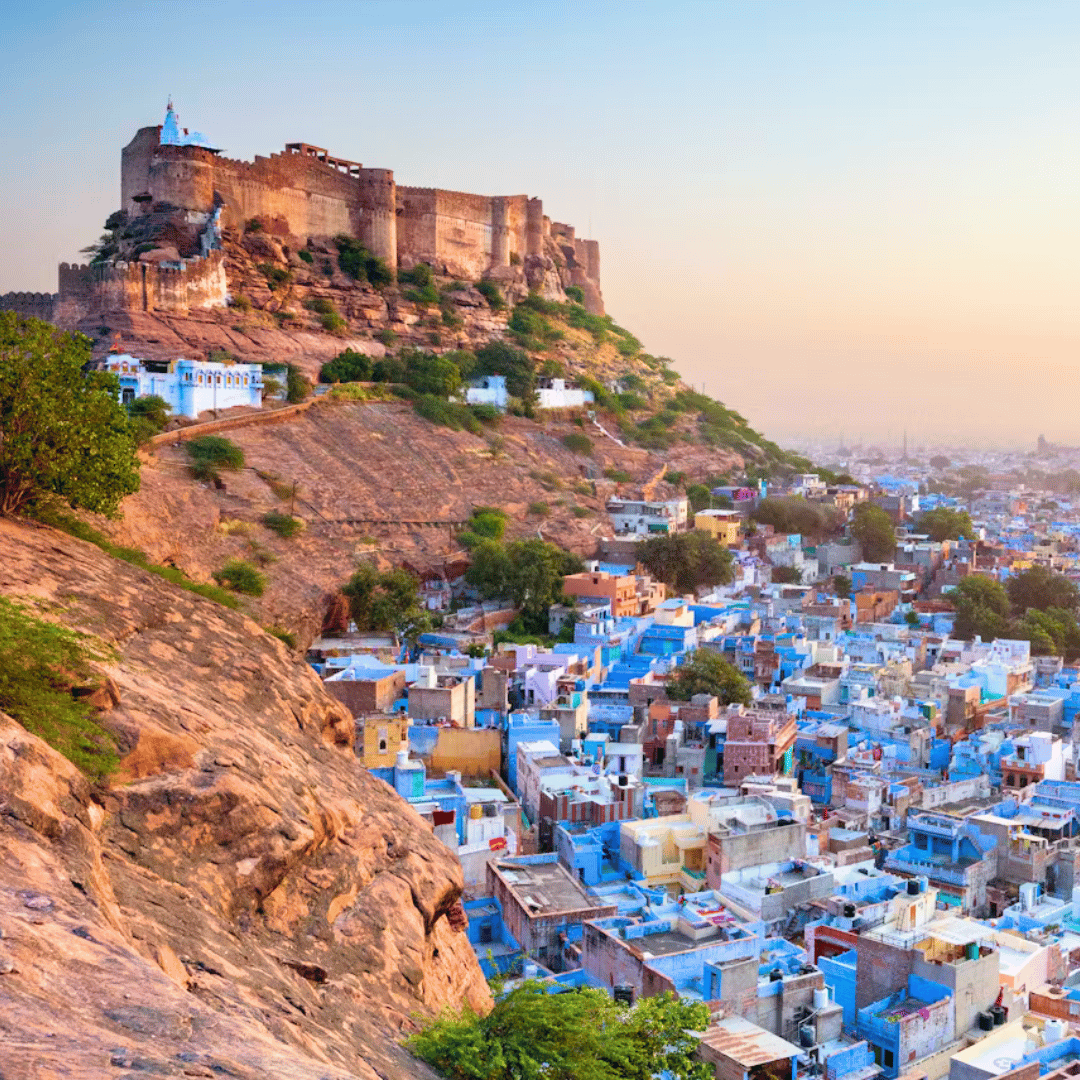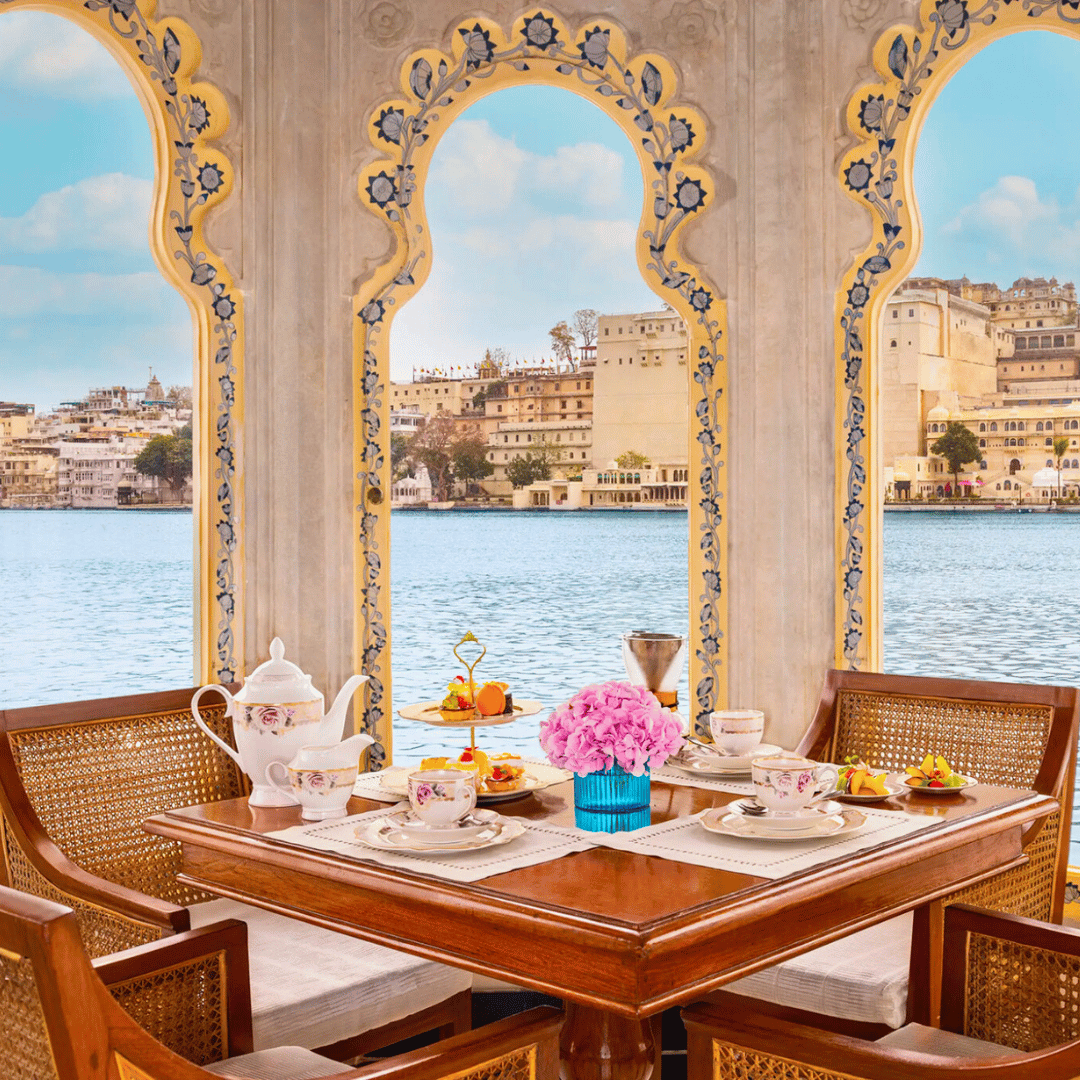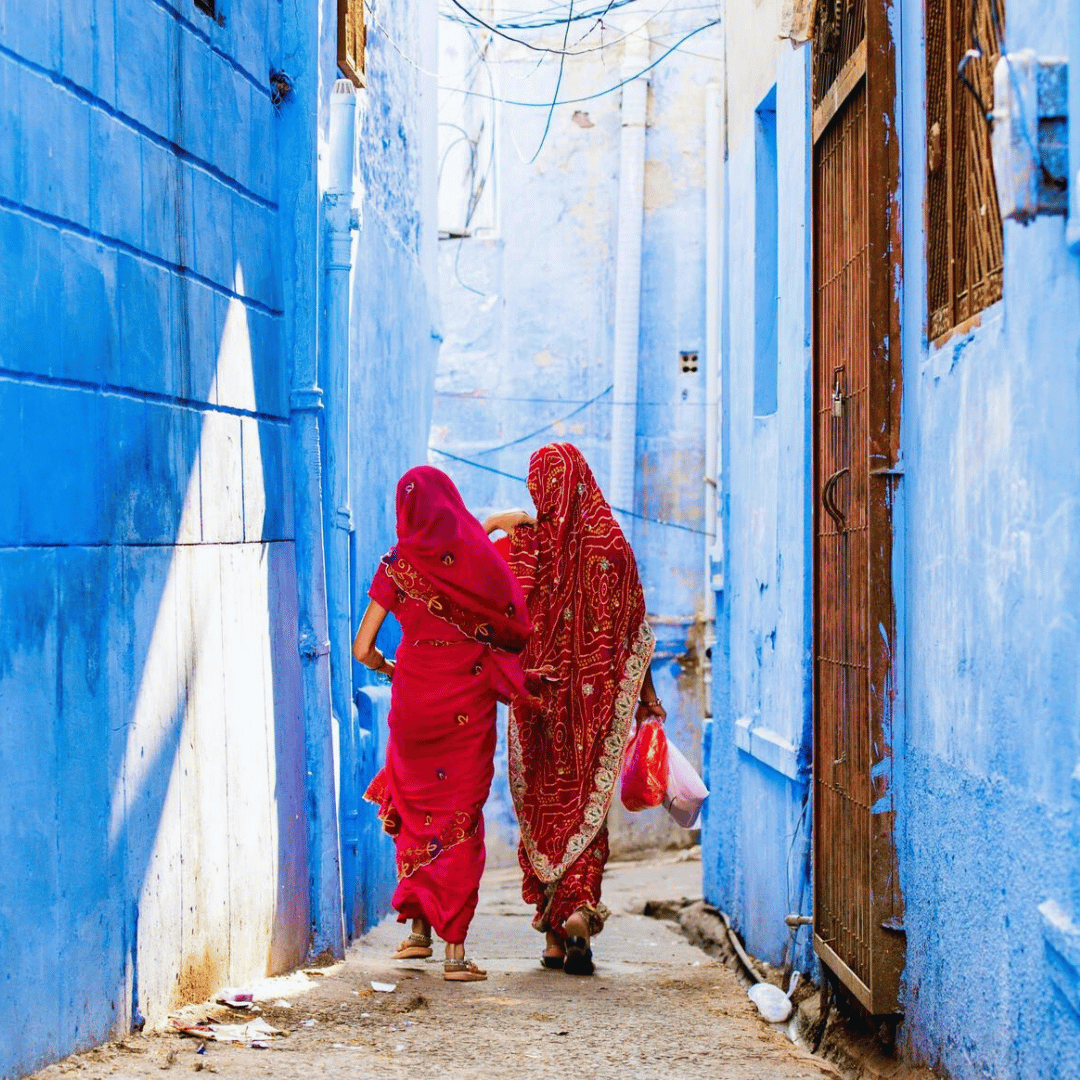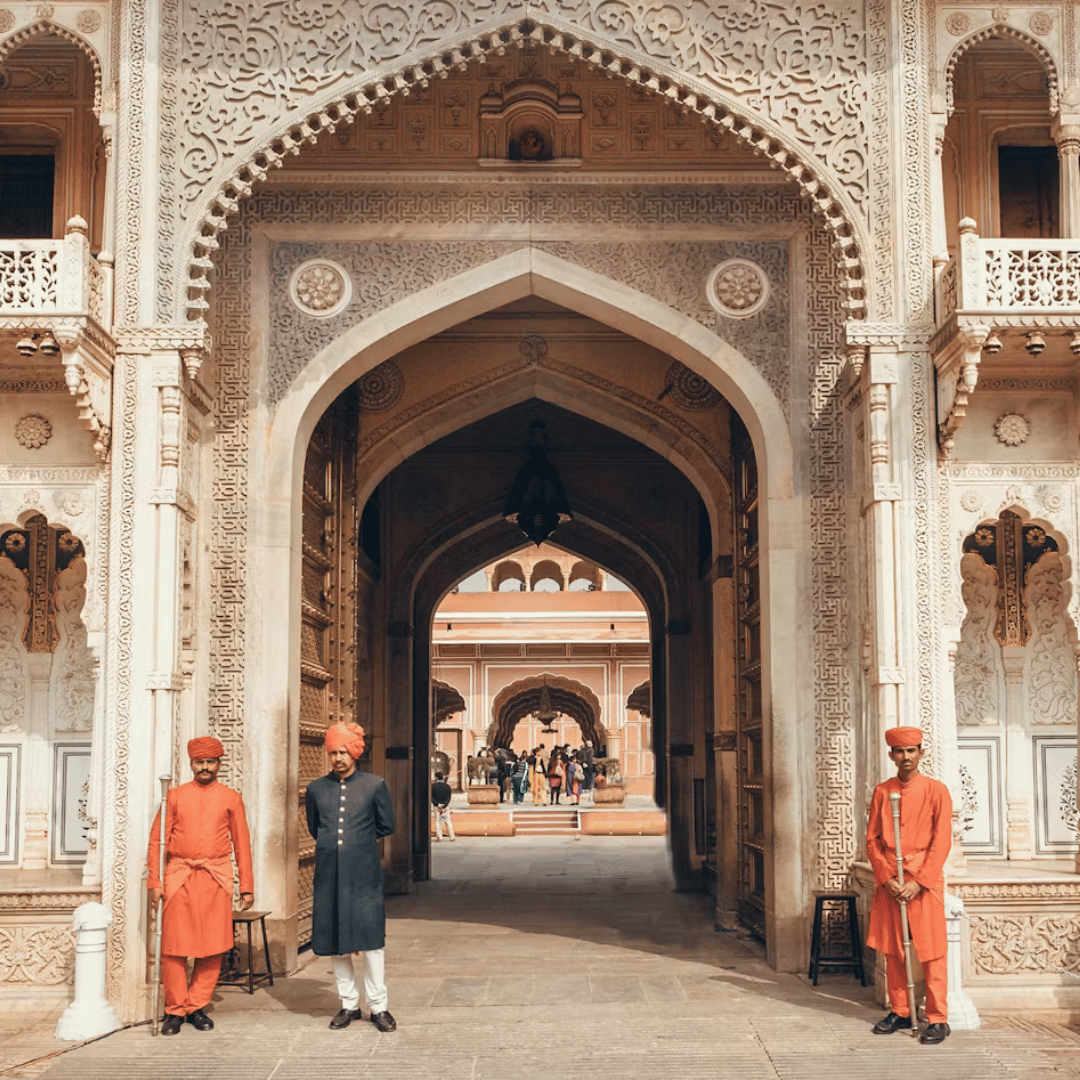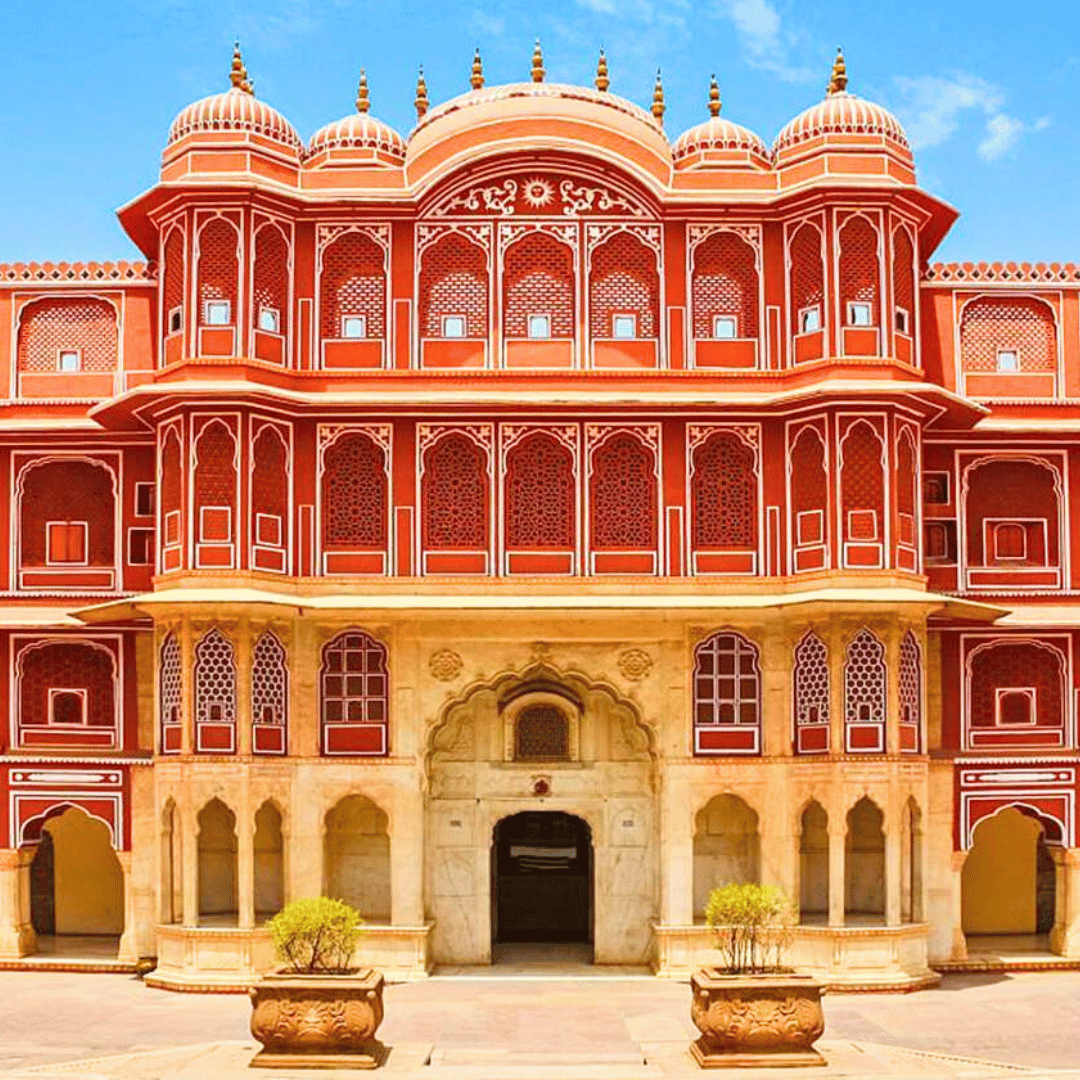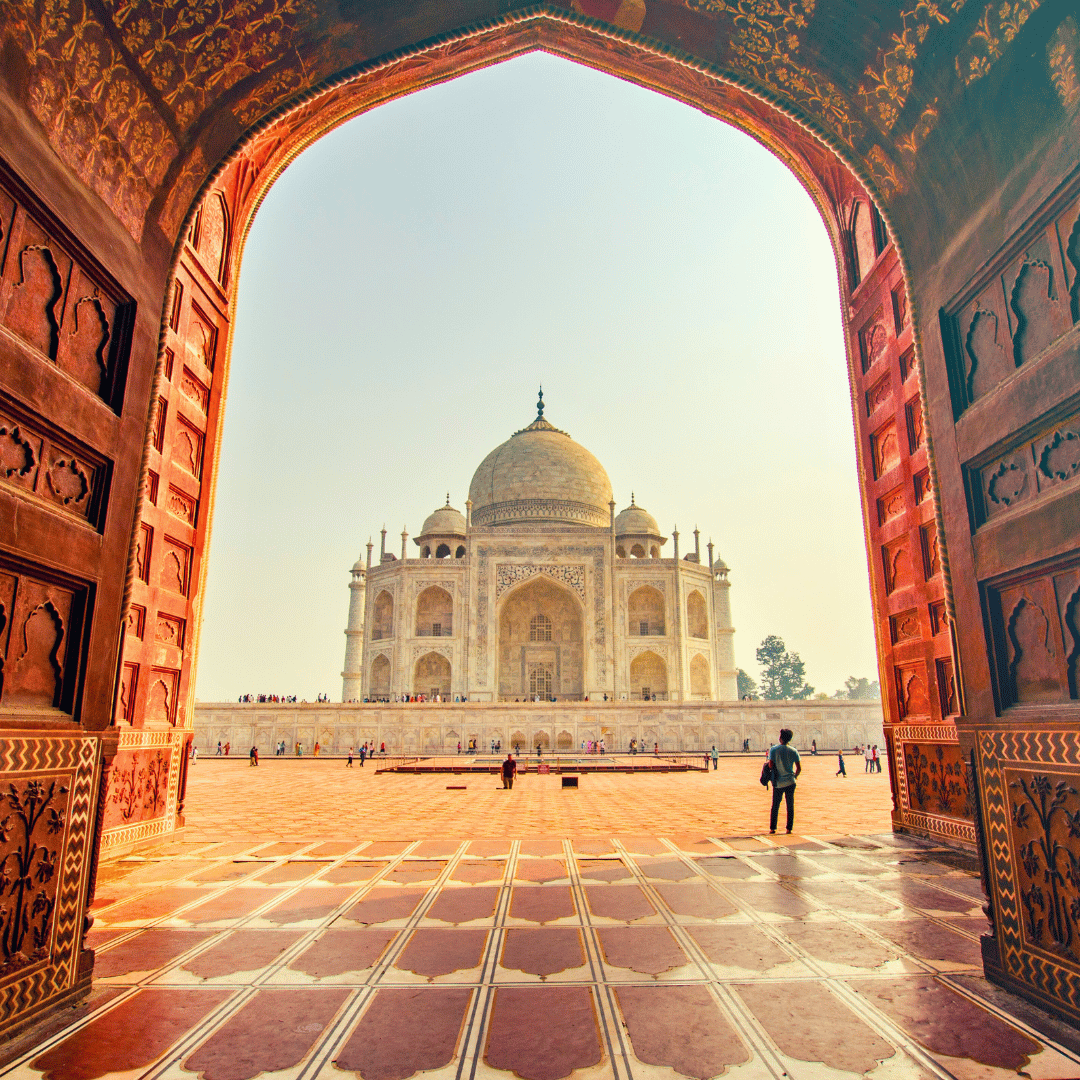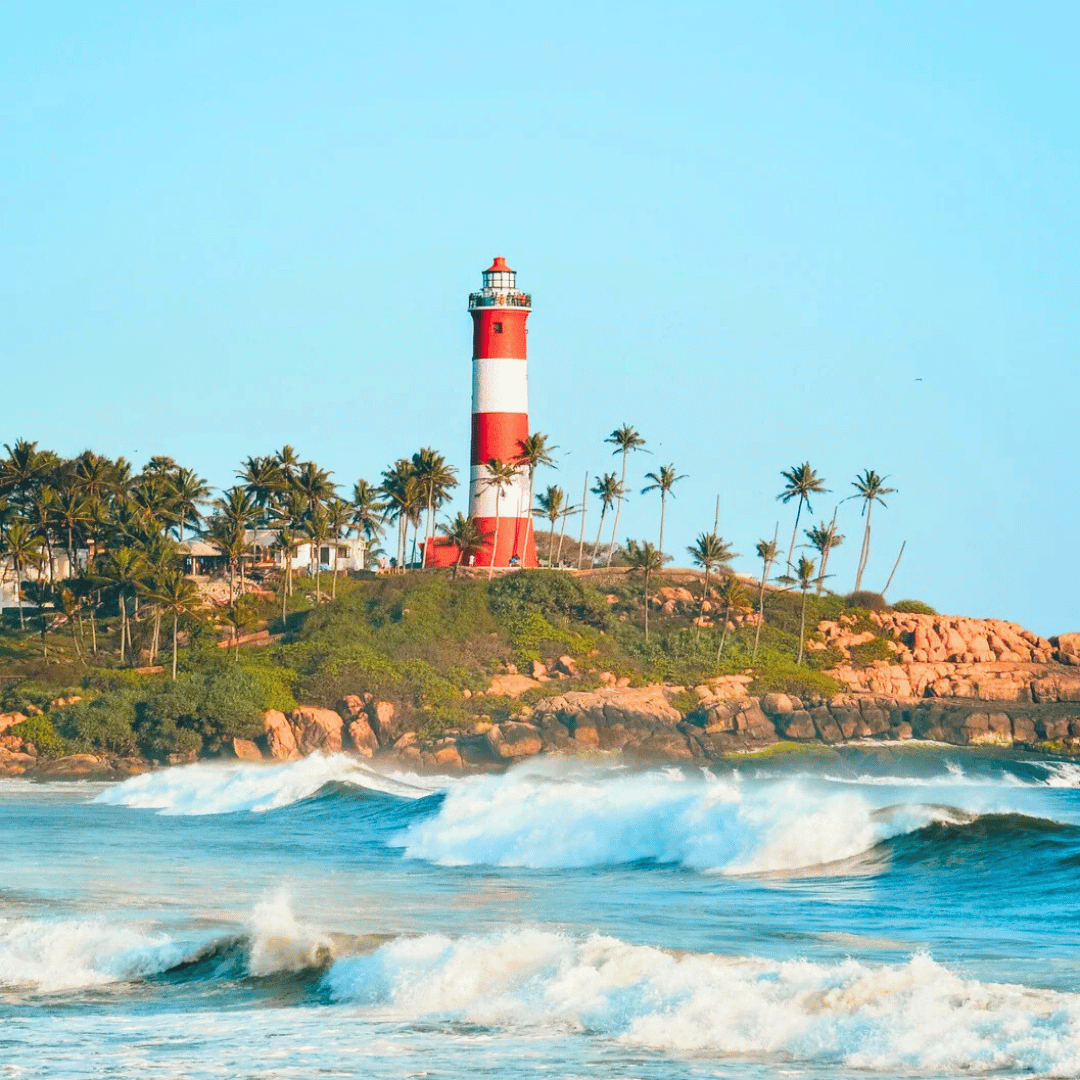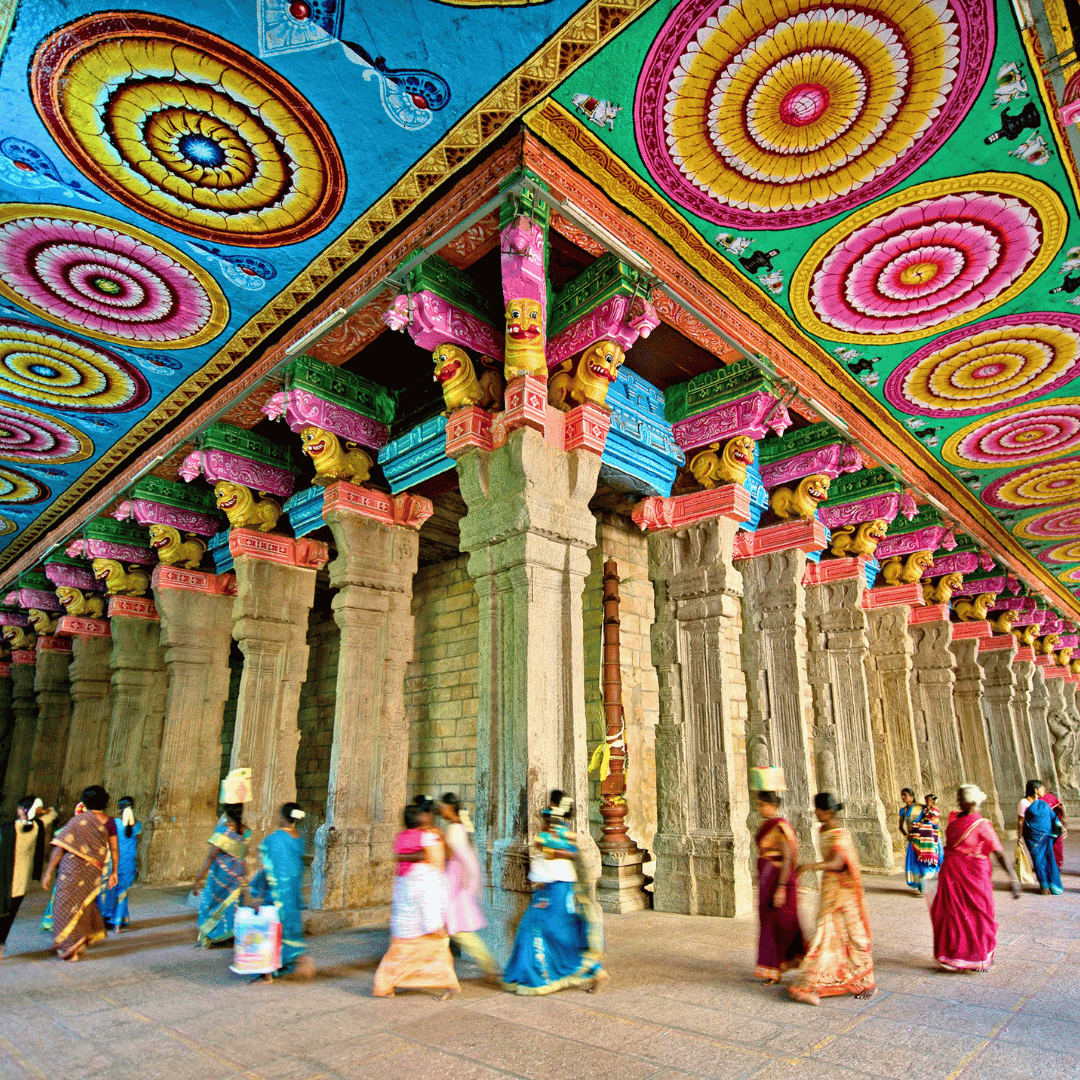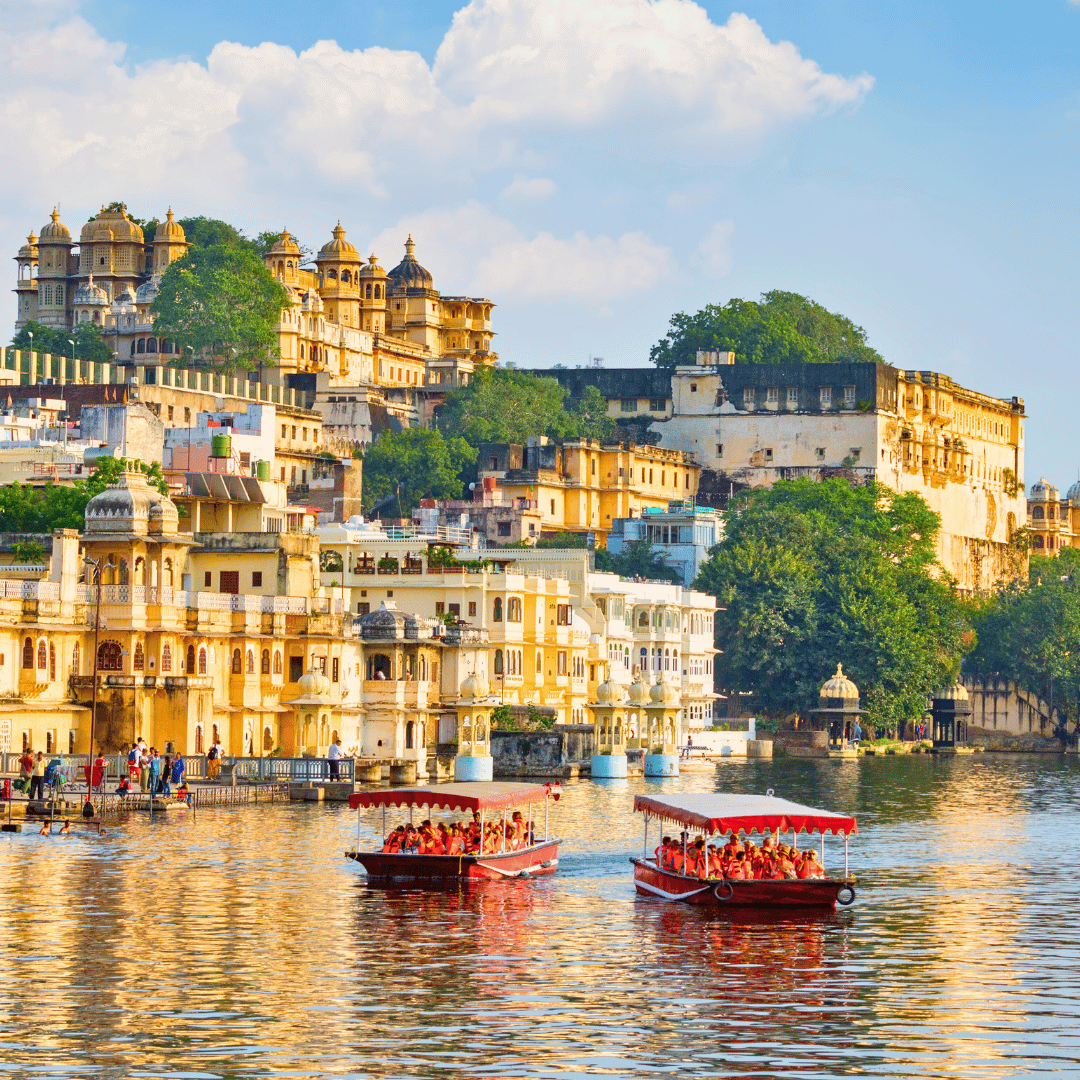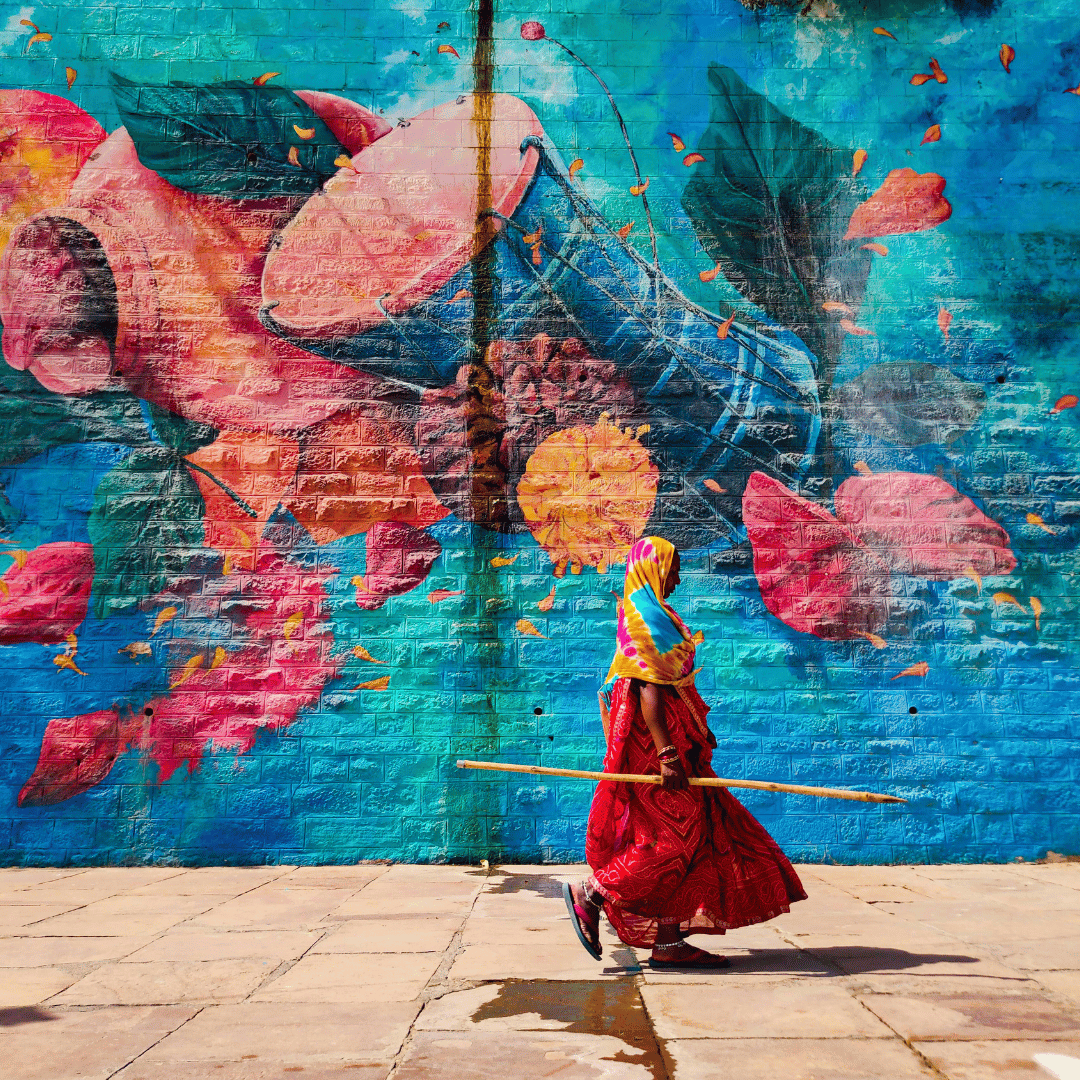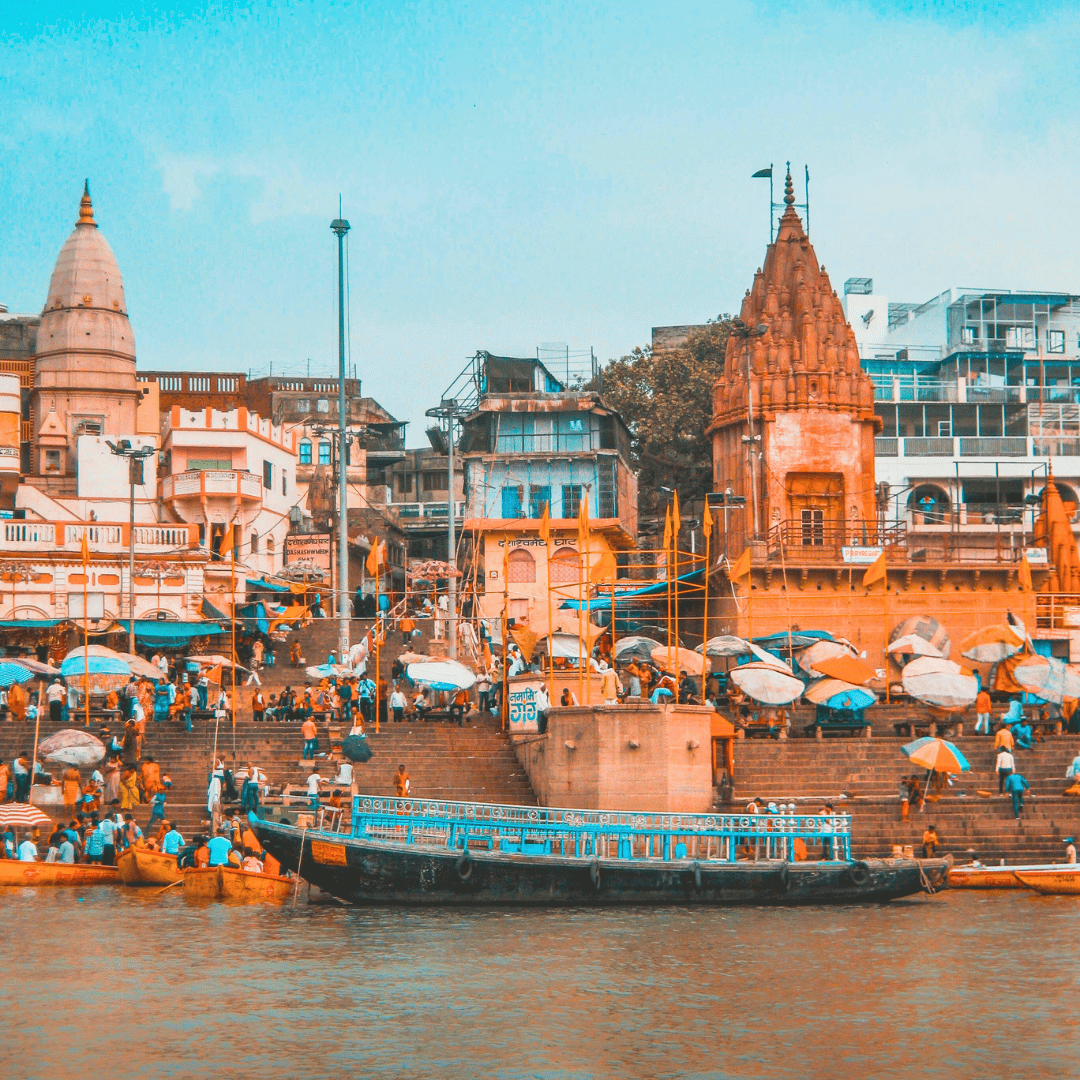Three Week Rajasthan Tour Itinerary
-
Welcome to India! On arrival in Delhi, you’ll be met by our local representative and transferred to your hotel.
India’s capital is a city of immense historical depth and striking contrasts, with layers of past empires still visible in its layout, architecture and culture. Over centuries, it has been shaped by a succession of rulers - from the early Delhi Sultanate to the Mughals, and later the British - each leaving behind their own imprint.
Today, Delhi is made up of two distinct parts. To the south lies New Delhi, built by the British in the early 20th century as the imperial capital. It’s known for its wide, tree-lined avenues, spacious parks, grand government buildings and stately colonial-era architecture. In contrast, Old Delhi in the north - formerly Shahjahanabad, established by Mughal emperor Shah Jahan in the 17th century - is a dense network of narrow lanes, crumbling havelis, centuries-old mosques and vibrant street life.
While these two areas appear starkly different, together they reflect the complexity and character of the city as a whole. Over the next two days, you’ll have the chance to experience the contrasts and connections between them - from imperial boulevards to hidden alleyways - and to begin uncovering the many layers that make Delhi such a compelling starting point for a journey through India.
-
Delhi offers an extraordinary mix of sights, sounds and experiences, with its history, culture and daily life unfolding side by side. This morning, you’ll explore the historic heart of the city - Old Delhi - where centuries-old traditions continue to thrive amidst the dense tangle of lanes, shops and shrines.
Begin with a visit to Jama Masjid, one of the most impressive mosques in India and the final architectural commission of the Mughal emperor Shah Jahan. Built between 1650 and 1656, the mosque is constructed from red sandstone and white marble, with intricate detailing in black onyx. Its vast courtyard can hold up to 25,000 worshippers, and the complex is crowned with three domes and flanked by two towering minarets. It remains an active place of worship and an enduring symbol of Delhi’s Mughal heritage.
Afterwards, take a guided walk through the old walled city of Shahjahanabad, founded by Shah Jahan in the 17th century. Your walk includes a visit to Khari Baoli, one of the largest wholesale spice markets in Asia. The market’s narrow alleys are packed with sacks of turmeric, chilli, cardamom and dried fruit, and the air is rich with the scent of spices. The market developed around the Fatehpuri Masjid, a mosque commissioned by one of Shah Jahan’s wives in 1650.
The name Khari Baoli comes from a now-lost stepwell (‘baoli’) once filled with saline (‘khari’) water, used for bathing animals and people. Though the well itself has long disappeared beneath the main road, the market continues to thrive, with many of the shops still run by descendants of the original trading families, now in their ninth or tenth generation. Wandering through the spice stalls, you’ll gain a vivid sense of the city’s commercial and cultural continuity, where history lives on in everyday exchanges.
-
Continue your exploration of Delhi today with a focus on New Delhi, the city’s modern and spacious southern half, developed during the British colonial period. Unlike the densely packed lanes of Old Delhi, New Delhi is marked by broad, tree-lined avenues, imposing buildings and carefully laid-out gardens, reflecting a very different chapter in the city’s history.
Your first stop is Humayun’s Tomb, one of the earliest examples of Mughal garden tomb architecture in India. Commissioned by Humayun’s senior widow, Empress Bega Begum, the mausoleum was completed in 1573 - nearly two decades after the emperor’s accidental death, having reportedly fallen down the stairs of his library on his way to prayer. The tomb is set within formal Persian-style gardens divided by water channels, forming a blueprint for later Mughal tombs, including the Taj Mahal. Its harmonious proportions, intricate inlay work and red sandstone facade mark the beginning of the architectural grandeur that came to define the Mughal era.
Next, visit the Qutab Minar, a soaring sandstone tower that stands 73 metres high and is considered one of the finest examples of early Indo-Islamic architecture. Construction began in 1193 under Qutab-ud-din Aibak, following the defeat of Delhi’s last Hindu rulers. Later additions by his successors brought the minaret to its current height. Surrounding the tower is a remarkable archaeological complex that includes the Alai Darwaza, with its striking domes and latticework, and the Quwwatu’l-Islam mosque, the oldest in northern India, built largely using materials salvaged from earlier Hindu temples.
Complete your day with a drive through Lutyens’ Delhi - the ceremonial heart of the city, named after British architect Sir Edwin Lutyens, who was commissioned to design the new imperial capital in the early 20th century. Along the way, you’ll see some of the city’s most recognisable landmarks, including India Gate and the sweeping avenues of Rajpath. One of the most striking buildings here is the Rashtrapati Bhavan, originally built as the Viceroy’s House and now the residence of the President of India. Larger than the Palace of Versailles, it is an extraordinary example of imperial ambition and colonial architecture, blending classical and Indian elements in its vast, domed design.
Together, these sites offer a compelling overview of Delhi’s historical layers - from the early Islamic sultanates to the Mughal empire and the colonial era - each era leaving its mark on the fabric of the capital.
-
Depart Delhi this morning for the drive to Agra, a journey of around 3.5 hours by road. As you leave the capital behind, the landscape opens up into fields and rural villages, offering glimpses of everyday life in northern India.
Agra, though believed to have been founded in 1504 by Sultan Sikander Lodi of the Delhi Sultanate, rose to prominence under the Mughal Empire. Re-named Akbarabad by Emperor Akbar, it served as one of the Mughal capitals and quickly became a centre of political power, culture and architecture. During the height of Mughal rule, Agra flourished as a hub of design and urban planning, and many of the most iconic buildings from the period can still be found here.
This afternoon, you’ll explore two of the city’s most significant landmarks: Agra Fort and the Taj Mahal. Agra Fort, like its counterpart in Delhi, is a powerful expression of Mughal might and elegance. Although the site had earlier fortifications, it was under Emperor Akbar that the current structure took shape. Between 1565 and 1573, thousands of labourers worked daily to build the red sandstone fort, transforming it into a walled city that housed palaces, audience halls and mosques. The fort remained in active use by successive emperors, including Jahangir and Shah Jahan, and its scale and architectural detail reflect the grandeur of Mughal imperial life.
Later in the day, visit the Taj Mahal, Shah Jahan’s enduring tribute to his wife Mumtaz Mahal. Widely regarded as one of the most beautiful buildings in the world, the Taj Mahal is the pinnacle of Mughal architecture, blending Persian, Indian and Islamic influences in perfect harmony. Built from white marble and inlaid with precious stones, it took more than 20 years and thousands of artisans to complete. Viewing the Taj Mahal in the soft light of late afternoon - when the marble glows with warm golden tones - is a moment to savour. This masterpiece continues to move visitors from around the world with its symmetry, detail and the poignant love story that inspired its creation.
-
This morning, depart Agra and travel by road to Jaipur, a drive of approximately five hours. En route, stop to explore the extraordinary deserted city of Fatehpur Sikri, built in the late 16th century by the Mughal emperor Akbar. Intended as a grand imperial capital, the city reflects Akbar’s fascination with Persian court culture and his inclusive approach to rule. While the layout follows Persian principles of symmetry and planning, the architectural details incorporate strong Hindu and Jain design influences, illustrating Akbar’s respect for the cultural and religious diversity of his empire.
The palace complex is made up of a series of elegant pavilions arranged geometrically on a flat plateau, echoing the layout of nomadic encampments from Central Asia and the Arab world. Akbar ruled from Fatehpur Sikri for only about 14 years before water shortages and strategic concerns led to its abandonment, yet the structures remain remarkably well preserved. The site offers a fascinating glimpse into a unique moment in Mughal history, where architecture, ideology and ambition converged.
Continue your journey to Jaipur, the capital of Rajasthan and one of the state’s most visually distinctive cities. Founded in 1727 by Maharaja Jai Singh II, Jaipur was designed as a planned city - a rarity in India at the time. Working with Bengali architect Vidhya Chakravarty, Jai Singh laid out the city based on principles outlined in the ancient Hindu architectural text, the Shilpa Shastra. The result was a grid of nine rectangular sectors, representing the nine divisions of the cosmos, with wide avenues, public squares and clearly demarcated zones for temples, palaces, markets and homes.
Jaipur’s earliest buildings, including havelis, temples and stepwells, were constructed in keeping with this cosmic plan and featured a harmonious blend of Rajput and Mughal architectural styles. Over time, the city became known as the ‘Pink City’ after it was painted in terracotta hues to welcome the Prince of Wales in 1876 - a tradition that continues to define its historic character today. Now a thriving modern capital with a population of over three million, Jaipur remains one of Rajasthan’s most popular and accessible cities, offering a captivating mix of heritage, design and urban energy.
-
Begin your exploration of Jaipur today with a visit to the impressive Amber Fort, one of the most striking examples of Rajput architecture in Rajasthan. Perched high on a rocky hill overlooking Maota Lake, the fort is a blend of Hindu and Mughal styles, built from red sandstone and white marble. Originally constructed by Raja Man Singh I in 1592 and later expanded by Mirza Raja Jai Singh, the fort houses a series of ornate palaces, temples and courtyards. Among its many highlights is the Sheesh Mahal, or Hall of Mirrors, where the walls and ceiling are intricately decorated with thousands of tiny mirror tiles that shimmer with reflected light.
Continue to the City Palace, located in the heart of Jaipur. This sprawling complex, still partially occupied by the royal family, was central to Maharaja Sawai Jai Singh II’s vision of a planned city. The palace grounds unfold in a sequence of courtyards and buildings, beginning with public spaces like stables and administrative areas, and moving inward to increasingly private royal quarters. At its centre is the Chandra Mahal, a seven-storey palace that remains a royal residence. The complex also houses a number of excellent museums, showcasing royal costumes, weaponry, and fine art - all testament to the opulence and cultural refinement of the former Jaipur rulers.
Nearby is the Jantar Mantar, an open-air astronomical observatory built by Jai Singh II in the early 18th century. It consists of an extraordinary collection of fixed masonry instruments, used to track the movements of celestial bodies with remarkable accuracy. Constructed from local stone and marble, many of these structures are the largest of their kind in the world, and the observatory was designated a UNESCO World Heritage Site for its scientific and architectural significance.
Just a short walk away stands the Hawa Mahal, or Palace of Winds, an ornate pink sandstone structure with a distinctive five-storey façade. Built in 1799, it was designed to allow the royal women to observe street processions without being seen. The façade is made up of 953 small windows, or jharokhas, decorated with intricate latticework - a beautiful example of the fusion between Rajput and Mughal design traditions.
End your day with a walking tour through the bazaars of Old Jaipur - the sensory heart of the city. Stroll through Johari Bazaar, known for its traditional jewellery and precious stones, and Maniharon Ka Rasta, where artisans create vibrant bangles in an array of colours and materials. The narrow laneways are alive with the sounds of trade, the scent of street food and incense, and the rich colours of textiles and handcrafted wares - a lively and immersive way to experience Jaipur’s enduring charm.
-
Today is left at leisure for you to relax at your hotel or continue exploring Jaipur at your own pace. This free day gives you the flexibility to revisit places that sparked your interest or discover new corners of the city that haven’t yet been explored.
For those keen to see Jaipur from a different perspective, there are several engaging experiences available. A guided bicycle tour in the early morning is a great way to explore the quieter side of the city as it begins to stir. These rides typically pass through old neighbourhoods, temples, and local markets, giving you an intimate glimpse of everyday life while avoiding the mid-day bustle.
Alternatively, a themed walking tour can offer a more in-depth view into the city’s hidden stories - from heritage lanes and artisan quarters to historic stepwells and lesser-known temples. You may wish to join a food walk to sample traditional Rajasthani snacks and sweets from beloved street vendors, or visit one of the city’s traditional craft studios to watch artisans at work on blue pottery, block printing or miniature painting.
Those interested in local culture might also enjoy a visit to the Anokhi Museum of Hand Printing, located just outside the city near Amber, which offers an excellent introduction to Jaipur’s textile heritage. Or, for a quieter afternoon, head to the beautiful Sisodia Rani Garden or enjoy tea at one of the city’s heritage hotels.
Whatever your preference, Jaipur is a city that rewards curiosity - and this free day gives you the chance to explore it in a way that suits your interests.
-
This morning, you’ll be collected from your hotel and driven to Deogarh, a journey of around five hours through the scenic countryside of Rajasthan. As you leave the bustle of Jaipur behind, the landscape gradually shifts to reveal rolling hills, scattered villages and open plains - offering a quieter and more rural side of the state.
Your accommodation in Deogarh is the magnificent Deogarh Mahal, a 300-year-old fort-palace that has been carefully restored and converted into a heritage hotel. Set atop a hill with sweeping views of the surrounding region, the palace offers a unique opportunity to stay in a property rich with history and architectural character. Built by the local ruling family in the 17th century, Deogarh Mahal features a maze of courtyards, fresco-lined halls, jharokhas (stone balconies) and beautifully detailed rooms.
The Deogarh family continues to live on the estate and is closely involved in the management of the hotel, bringing a sense of personal warmth and continuity to the experience. Their presence and attention to detail have helped make Deogarh Mahal one of Rajasthan’s most admired heritage stays, combining regal charm with genuine hospitality.
After checking in, the remainder of your day is at leisure. You may wish to explore the palace grounds, take in the views from the terraces, or simply relax and enjoy the peaceful atmosphere of this historic retreat.
-
This morning, enjoy a short and scenic train ride through the hills surrounding Deogarh - a charming and down-to-earth experience that offers a glimpse into everyday rural life. The train travels slowly through the rugged Aravalli landscape, winding past rocky outcrops, tiny villages and open fields. It's a local commuter route, so you're likely to share the carriage with villagers on their daily journeys, often accompanied by bundles of produce or even the occasional goat. The relaxed pace and informal atmosphere make it a wonderful way to interact with locals and witness a slice of life that hasn’t changed much over time.
The rest of the day is yours to spend as you wish. You may simply choose to relax at Deogarh Mahal, enjoying the property’s peaceful courtyards, rooftop views and comfortable surrounds. Or, for those keen to explore further, Deogarh offers a variety of experiences.
You might like to take a gentle walk or trek through the nearby hills, explore the countryside on horseback, or visit the area’s many small lakes, which are ideal for birdwatching or a quiet boat ride. For those with an interest in local history, nearby Gokul Garh Fort and Anjana Fort are worth visiting, each offering impressive views and a sense of the region’s layered past.
-
This morning, you'll depart Deogarh and travel by road to Udaipur, a drive of approximately three hours. Along the way, stop to visit the remarkable Ranakpur Temples, set in a quiet valley of the Aravalli Hills. Considered one of the most significant Jain temple complexes in India, Ranakpur is a masterpiece of religious architecture and intricate stone carving.
Built in the 15th century, the temples are still an active place of pilgrimage for followers of Jainism and have been remarkably well preserved over the centuries. The main temple, known as Chaumukha or “Four-Faced Temple,” is dedicated to Adinath, the first Jain Tirthankara (spiritual teacher). Elevated on a high platform and covering over 4,400 square metres, the temple features 29 halls and is supported by an astonishing 1,444 intricately carved marble pillars - no two alike. The design allows sunlight to filter through in ever-changing patterns, creating a play of light and shadow that adds to the temple’s sense of serenity and awe. Within the complex are two smaller temples dedicated to Neminath and Parasnath, which are also finely detailed and peaceful in their setting.
After taking time to explore the site, continue your journey to Udaipur, one of Rajasthan’s most picturesque cities. Often referred to as the “City of Sunrise” or the “Venice of the East,” Udaipur is known for its shimmering lakes, whitewashed palaces, and romantic skyline. It was founded in 1559 by Maharana Udai Singh, a ruler of the Sisodia dynasty of Mewar - a proud and fiercely independent Rajput clan who trace their ancestry to the sun god, Surya. The sun emblem, symbolic of their lineage, can still be seen throughout the city on flags, gates and temple walls.
Udaipur was once the capital of the Mewar kingdom, and its royal legacy lives on in the City Palace complex, still partially occupied by the current Maharana - the 76th ruler in a dynasty that stretches back more than 1,500 years. With its rich heritage, lakeside setting and elegant architecture, Udaipur offers a very different atmosphere to the desert cities of Rajasthan - one of calm, refinement and quiet grandeur.
-
Begin your exploration of Udaipur with a visit to the grand City Palace, an architectural masterpiece that dominates the eastern shore of Lake Pichola. The palace is the largest of its kind in Rajasthan and offers a striking blend of Rajput and Mughal design influences. Rather than a single structure, it is a sprawling complex of interconnected palaces, each added by successive rulers over the centuries. Winding corridors lead through a maze of courtyards, balconies, towers, cupolas and gardens - all built from gleaming marble and granite.
Inside, the palace reveals an extraordinary level of craftsmanship. Delicate mirror work, intricate marble inlay, ornate silver doors, stained glass windows and detailed murals adorn the walls and ceilings. Every room tells a story, whether it’s through the art that decorates it or the view it commands over the lake and city below. The palace museum showcases royal artefacts and gives a fascinating glimpse into the history of the Mewar dynasty.
A short walk from the main palace gate brings you to Jagdish Temple, a beautifully preserved 17th-century temple dedicated to Lord Vishnu. Built in the Indo-Aryan style, the temple is raised on a high terrace and approached by a flight of steps flanked by stone elephants. At its entrance stands a bronze statue of Garuda, Vishnu’s divine mount, watching over the worshippers who come to pay their respects. The temple remains an active place of devotion and is a vital part of Udaipur’s cultural life.
To end your morning, enjoy a stroll through Saheliyon-ki-Bari, an elegant garden built in the 18th century for the royal ladies of the court. Designed as a place of leisure for the queen and her 48 attendants - said to have been part of her dowry - the garden features decorative fountains, a lotus pool, marble pavilions and lush flowerbeds. With its shaded walkways and gentle sound of water, it offers a tranquil retreat from the heat of the day and a glimpse into the refined lifestyle of Udaipur’s royal women.
-
Enjoy a full day at leisure in Udaipur, with time to relax or explore the city at your own pace. Known for its romantic lakes, historic palaces and strong artisan traditions, Udaipur also offers a range of immersive experiences that go beyond sightseeing.
For those interested in food and culture, a cooking class at Devra offers a relaxed and engaging way to learn about Rajasthani home-style cuisine. Located just 15 minutes from the city centre, Devra is a charming stone-clad country villa set on a five-acre estate with beautiful views of the Aravalli Hills and surrounding farmland. Hosts Major Durga Das and Jyoti Jasol are gracious and knowledgeable, sharing both culinary tips and stories about local traditions. The session ends with a home-cooked meal enjoyed in the garden or dining room, making for a warm and memorable experience.
If you’re drawn to the arts, consider joining a miniature painting class at Painting House Art School, located in the nearby village of Sisarma. This open-air school sits on the edge of Lake Pichola and offers views of the City Palace in the distance. Run by professional miniature artists, the school teaches traditional techniques using natural pigments and even real gold and silver on a variety of surfaces including paper, marble and silk. You’ll be introduced to a range of classical subjects, from royal processions and court scenes to flora, fauna and mythological themes.
For a more active way to experience the region, Udaipur’s diverse surroundings make it an ideal place for a morning cycling tour. You can choose between an 18km or 30km ride, each offering a refreshing contrast to the city’s built-up areas. Starting early, the route weaves past local schools, markets and temples before opening out into the countryside. Expect to pass through farming villages, open fields and grazing pastures, with plenty of chances to observe daily life, local wildlife and the natural rhythms of rural Rajasthan. A picnic lunch or meal at a local restaurant rounds out the ride.
Whether you choose to deepen your understanding of local food, try your hand at a centuries-old art form, or pedal your way through the rural outskirts, today is a wonderful chance to experience Udaipur on your own terms - relaxed, engaging and full of character.
-
Today you’ll be driven to the village of Narlai, a journey of around three and a half hours through the scenic Aravalli hills. Located between Udaipur and Jodhpur, Narlai offers a peaceful contrast to Rajasthan’s larger cities, with its quiet lanes, painted houses and traditional rural lifestyle.
Your accommodation is at Rawla Narlai, a beautifully restored 17th-century fort that once served as a royal hunting lodge. Originally gifted by Maharaja Umaid Singhji of Jodhpur to his younger brother, Maharaja Ajit Singhji, the property remained in the family for generations. In more recent years, Maharaja Swaroop Singh took on the task of restoring the crumbling structure, transforming it into an elegant heritage retreat that retains its original charm while offering modern comforts.
Set in the heart of the village, Rawla Narlai blends effortlessly into its colourful surroundings, where cows roam freely, locals gather at tea stalls, and daily life continues much as it has for centuries. Inside the Rawla, however, you’ll find a tranquil haven of shaded courtyards, quiet verandahs, intricately carved stonework and beautifully appointed rooms - many with antique furnishings and views over the surrounding countryside.
Towering above the village is a striking 107-metre-high granite monolith, visible from much of the property. Dotted with ancient caves and small shrines, the rock is crowned by a statue of a white elephant, believed to be a guardian of the village. On one side, the desert stretches out toward Jodhpur - on the other, the green folds of the Aravalli hills roll into the distance.
This peaceful setting makes Rawla Narlai a wonderful base for soaking up rural Rajasthan. Whether you choose to relax within the hotel’s calm atmosphere or take a wander through the surrounding village, you’ll find yourself immersed in a slower, more intimate side of Rajasthan.
-
Today is yours to enjoy at leisure in Narlai, a peaceful village that offers a welcome pause from the pace of Rajasthan’s cities. Surrounded by rugged hills, ancient temples and quiet farmland, it’s an ideal setting to slow down and soak in the atmosphere of rural India.
You may like to begin the day with a stroll through the village itself. Life here continues much as it has for generations, with friendly locals, painted houses, and craftsmen at work in small workshops. It’s a wonderful place to simply wander and observe - children walking to school, women drawing water from wells, or traders setting up their stalls for the day.
For something more active, consider a walk to the top of the towering granite hill that rises above the village. The climb is steep in parts but rewarding, offering panoramic views of the surrounding countryside. Along the way, you’ll pass small temples and carved stone steps, and at the summit you’ll find the white elephant statue that watches over Narlai.
Other options for the day include a visit to the nearby 7th-century stepwell, a beautifully constructed multi-storey structure built to harvest and store water. Its architectural symmetry and historical significance make it a lovely site to explore. Some evenings, the hotel arranges atmospheric dinners by candlelight at the stepwell - a unique experience worth considering.
Birdwatching is another quiet activity that Narlai lends itself well to, with a number of species commonly found around the nearby lake and farmlands. Early mornings and late afternoons are the best times to spot kingfishers, egrets, peacocks and other local birds.
For those interested in culture, the hotel can also arrange village walks with a guide, offering a chance to engage more deeply with local life, or visits to nearby temples with insights into their history and significance.
Whether you choose to unwind within the peaceful courtyards of Rawla Narlai or explore the landscapes and traditions that surround it, today offers a gentle and authentic window into village life in Rajasthan.
-
After breakfast, depart Narlai and begin the drive to Jodhpur, a journey of around three hours through semi-arid countryside and low-lying hills. As you approach the city, the landscape begins to flatten and open out, giving way to the stark, dry beauty of the Thar Desert region.
Jodhpur, Rajasthan’s second largest city, is often called the ‘Gateway to the Thar’ for its location on the very edge of the desert. Founded in 1459 by Rao Jodha, a powerful Rajput ruler of the Rathore clan, Jodhpur became the capital of the former princely state of Marwar and an important centre of trade and culture. Today, it remains one of Rajasthan’s most atmospheric cities, known for its history, architecture and vibrant local life.
At the city’s heart towers the mighty Mehrangarh Fort, one of the largest and most formidable forts in India. Perched on a rocky outcrop, it dominates the skyline and is still run by descendants of the royal family. The old walled city spreads out from the base of the fort in a maze of narrow, winding lanes and busy bazaars. These lanes are lined with blue-painted houses - a tradition once associated with the Brahmin caste, but now adopted more broadly - earning Jodhpur its nickname, the ‘Blue City’.
On arrival, check in to your hotel. The remainder of the day is yours to relax or begin exploring at your own pace. You might like to enjoy the views from your hotel rooftop, take a short walk through the local neighbourhood, or simply rest after your journey in preparation for exploring the city in more depth tomorrow.
-
This morning, set out to explore two of Jodhpur’s most iconic landmarks - the commanding Mehrangarh Fort and the delicate beauty of Jaswant Thada.
Rising dramatically from a rocky escarpment, Mehrangarh Fort dominates the city skyline and seems almost to grow out of the sandstone it rests upon. Built in the mid-15th century by Rao Jodha, the founder of Jodhpur, the fort has been expanded by successive rulers over more than five centuries. As a result, it features a fascinating mix of architectural styles, ranging from the austere defensive structures of its early years to the ornate palaces and courtyards added during more prosperous times. Rudyard Kipling once described it as “the work of giants,” and its colossal size, soaring walls and intricately carved interiors support that view.
Within the fort, you'll find one of Rajasthan’s finest palace complexes, housing royal apartments, audience halls and galleries. Many of these now form part of an exceptional museum, which showcases ceremonial arms, fine textiles, miniature paintings, royal cradles and palanquins, offering a vivid portrait of courtly life in Marwar. The views from the fort’s ramparts stretch across the blue-washed houses of the old city and into the desert beyond.
Just a short distance away lies Jaswant Thada, a striking white marble memorial built in 1899 to honour Maharaja Jaswant Singh II. In contrast to the fort’s imposing presence, this cenotaph is delicate and serene, with finely carved marble sheets so thin and polished they glow softly in the sunlight. Set within peaceful gardens overlooking a lake, it offers a quiet space to reflect and admire the craftsmanship of Rajasthan’s stonemasons.
In the afternoon, head into the heart of the old city to visit the lively Clock Tower, a well-known landmark and meeting point surrounded by the vibrant bustle of Sardar Market. Here, the narrow lanes are packed with stalls selling everything from colourful textiles, handcrafted jewellery and embroidered shoes to spices, teas and household goods. It’s a sensory experience - rich in colour, sound and local life - and a great place to pick up a memento or simply soak in the atmosphere of one of Rajasthan’s most dynamic marketplaces.
-
After a leisurely breakfast, you’ll be collected from your hotel in Jodhpur and driven to the ancient town of Osiyan, a journey of just over an hour through the semi-arid landscapes that mark the edge of the Thar Desert.
Often referred to as the “Khajuraho of Rajasthan,” Osiyan is renowned for its remarkable group of early medieval temples. This once-thriving trading town was an important religious and cultural centre between the 8th and 12th centuries, attracting both Jain and Hindu devotees. Though small in size today, Osiyan’s temple complex reflects the prosperity and artistic achievement of its golden age.
The town is home to a number of exquisitely carved temples dedicated to deities such as Surya (the sun god), Vishnu, Kali and various Jain Tirthankaras. The most prominent among them is the Sachiya Mata Temple, dedicated to the mother goddess and perched on a hill overlooking the desert plains. Dating back to the 9th century, this temple is known for its fine sculptural work, intricately carved columns, and torana-style arches. Another important site is the Mahavira Jain Temple, considered one of the oldest Jain temples in the region, notable for its detailed carvings and architectural balance.
Surrounded by sand dunes and sparse vegetation, Osiyan offers a striking contrast to the dense urban environment of Jodhpur. It is often considered an oasis, not only in the literal sense but also for its rich artistic and religious heritage set against the stark desert backdrop.
The town is also a popular base for camel rides and desert walks, offering a taste of life on the edge of the Thar. Depending on your interests and the time available, you might like to take a short ride through the nearby dunes or simply spend time wandering through the quiet lanes of this ancient town.
-
Enjoy a full day at leisure in Osiyan, with time to relax or explore at your own pace. While modest in size today, Osiyan was once a flourishing centre of trade, religion and culture - a vital stop along the old caravan routes connecting India with Central Asia. Its position along these ancient routes brought prosperity to the town, particularly during the early medieval period, when wealthy Jain merchants commissioned the construction of temples that still stand today.
These structures, dating from the 8th to the 12th century, are among the earliest examples of temple architecture in Rajasthan. Built from local sandstone, their fine carving and geometric detailing are remarkable, especially given the arid environment in which they were created. The scale of the temples is relatively modest, but their craftsmanship and historical importance are immense. Walking among them offers a unique window into the early development of temple design in western India, well before the more elaborate styles seen in later centuries.
Osiyan’s peaceful atmosphere, away from the larger tourist circuits, makes it an ideal place for unhurried exploration. The town’s sandstone buildings, narrow lanes and desert surroundings provide a photogenic and contemplative setting. You may also wish to take a short walk into the nearby dunes, where small shepherd communities still live a semi-nomadic lifestyle, or enjoy a quiet moment at one of the town’s temple platforms, where locals often gather in the late afternoon.
As the sun sets, the temples and desert landscape are bathed in warm golden light - a perfect end to a day spent uncovering the quieter, yet no less fascinating, side of Rajasthan’s cultural history.
-
This morning, you’ll depart Osiyan and travel by road to Nagaur, a drive of approximately two hours through the arid plains of western Rajasthan. On arrival, you’ll discover a town that feels largely untouched by the rapid pace of modern development - a place where crumbling havelis, narrow lanes and centuries-old rituals still define daily life.
Nagaur is best known for its magnificent fort - a sprawling complex enclosed by imposing sandstone walls that speak to the town’s strategic importance in earlier times. While less visited than Rajasthan’s more famous forts, Nagaur Fort is one of the most atmospheric, offering a rare sense of quiet grandeur. Originally built in the 12th century and later expanded by the Mughals, the fort is home to a remarkable collection of palaces, audience halls, courtyards, temples and water reservoirs, many of which are adorned with beautifully preserved murals and intricate architectural detailing.
One of the highlights of staying in Nagaur is the chance to spend the night within the fort itself. Ranvas, a luxury heritage hotel located inside the fort walls, offers a unique blend of historic charm and modern comfort. Once the residence of royal queens, the restored havelis of Ranvas now form a tranquil and elegant retreat, with shaded courtyards, quiet verandahs and traditionally inspired rooms that reflect the region’s architectural heritage.
The remainder of the day is free for you to relax and take in the peaceful surroundings. You may wish to wander through the fort’s quieter corners, admire the intricate frescoes and stonework, or simply enjoy the stillness that sets Nagaur apart from the busier destinations in the region.
Nagaur is also known for hosting one of Rajasthan’s largest and most colourful cattle fairs each February, when traders, livestock, and folk performers descend upon the town in a celebration of rural life. While your visit may not coincide with the fair, the town’s laid-back charm and deep historical roots offer a rich experience in any season.
-
This morning, you’ll depart Nagaur and drive to Mandawa, a journey of approximately three and a half hours. As you travel north-east through the arid plains of Rajasthan, the landscape gradually flattens out, opening into the semi-desert terrain of the Shekhawati region. While the land here may appear stark and barren, it hides some of the most fascinating artistic and architectural treasures in the state.
Mandawa sits at the heart of Shekhawati, an area once thriving with trade and commerce due to its strategic location along caravan routes connecting inland India with the ports of Gujarat. In the 18th and 19th centuries, the region’s wealthy Marwari merchant families invested their fortunes in the construction of grand havelis - opulent mansions richly adorned with frescoes. These painted buildings reflect a unique artistic tradition, with murals that depict everything from Hindu deities and local legends to colonial steam trains, European-style clocks, and hot air balloons - all illustrating the changing aspirations and influences of the era.
Although many of the havelis have aged gracefully and some have faded under the desert sun, the artistry and scale of these frescoes remain impressive and evoke the region’s once-flourishing prosperity. In addition to the havelis, Shekhawati towns like Mandawa are also home to a number of other historic structures including small forts, intricately carved cenotaphs (chhatris), traditional step-wells (baoris), and quiet mosques.
On arrival in Mandawa, check into your hotel - many of which are themselves housed in restored heritage properties, offering a blend of local character and comfort. The remainder of the day is at leisure. You may wish to relax in the courtyard, take a short walk through the town’s winding lanes, or simply admire the artwork that adorns so many of the buildings around you.
-
Today is devoted to exploring the painted havelis and artistic heritage of Mandawa and the broader Shekhawati region - often referred to as Rajasthan’s open-air gallery. This area flourished between the 18th and early 20th centuries, when prosperous Marwari merchant families, enriched by trade along the caravan routes to Gujarat’s ports, poured their wealth into constructing opulent homes. These havelis were not only residences but statements of status, decorated in extraordinary detail with bold and colourful frescoes.
The havelis themselves are architectural treasures, with intricately carved wooden doors, overhanging balconies, jharokhas (stone windows), and latticed screens. The exteriors and interiors are covered with frescoes - narrative murals that vividly capture scenes from Hindu mythology, local folklore, and daily life. You’ll see depictions of gods and goddesses, especially Krishna and Rama, alongside animals, floral motifs, and scenes from epics such as the Ramayana and Mahabharata.
As time moved forward, so too did the themes. In the later frescoes, Western influences began to appear - a nod to colonial contact and changing times. Steam trains, gramophones, hot air balloons, bicycles, European gentlemen in bowler hats and ladies in Victorian dresses are painted with the same flair as divine chariots and celestial beings. This blend of the sacred and the secular, the traditional and the modern, makes the frescoes of Shekhawati truly unique in Indian art history.
While Mandawa is known for some of the best-preserved havelis, nearby towns such as Nawalgarh, Fatehpur and Dundlod are also worth visiting, each with its own cluster of painted mansions, temples and step-wells. Some of these step-wells (baoris) remain in use today and feature beautifully painted domed pavilions in their corners, a sign of how artistry was once infused into the most practical of structures.
You may choose to explore the area on foot, by car, or even by camel cart. However you explore, your day in Shekhawati will offer a vivid glimpse into a bygone era of artistry, trade and cultural fusion that continues to quietly endure in this little-visited corner of Rajasthan.
-
This morning, you’ll be collected from your hotel in Mandawa for the drive back to Delhi, a journey of approximately four hours. On arrival in Delhi, you’ll be transferred to the airport for your onward flight - whether returning home or continuing to another destination in India. If you’re planning to extend your stay, this may be the perfect time to unwind with a few days of rest and relaxation, perhaps on the beaches of Goa or Kerala, or in the foothills of the Himalayas.
The India Unbound Difference
At India Unbound, we’ve spent twenty years on the ground in India, learning all about its intricacies, landscapes and cultures. We use this first-hand knowledge to carefully curate travel itineraries for our guests, and are proud to be a reputable private touring specialist. In addition, our team of local partners offer guarantees of punctuality, quality and service. All of our India private tour itineraries include all accommodation mentioned, daily breakfasts and other meals as specified, all transfers, touring and sightseeing by air-conditioned Toyota Innova or similar vehicle, and internal flights as outlined in the itinerary. Private activities and sightseeing with English-speaking local guides are included, along with entrance fees, drinking water in the vehicle, and all vehicle-related charges such as tolls, parking fees, and taxes. The cost does not include visas or international flights, personal expenses such as drinks and laundry, meals and activities not specifically listed as included, or camera fees, which are rarely applicable. Prices are listed in Australian dollars and are based on per person, twin share. Please note that these may fluctuate depending on the time of year you’re looking to travel, and the type of accommodation you prefer.

